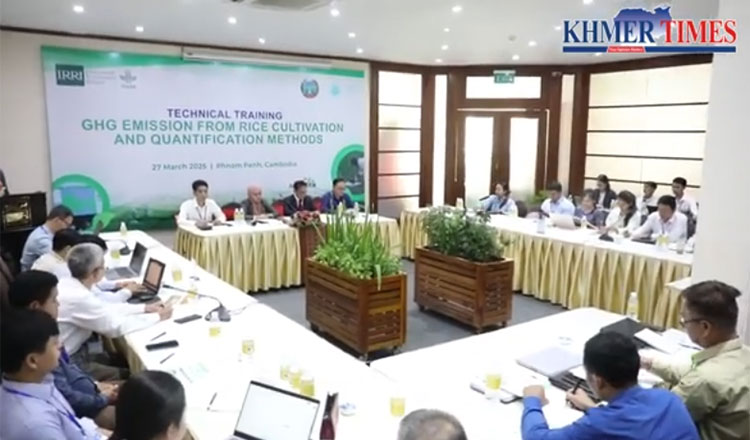Tags
In Bali, water temple priests guide a sustainable rice production system
Elizabeth Sinclair
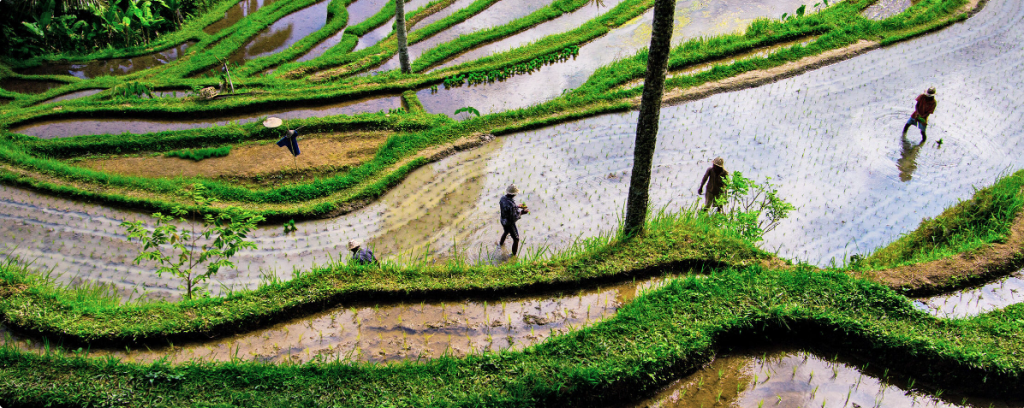
- Subak is an ancient rice irrigation system developed in line with the Balinese philosophy of Tri Hita Karana, which holds that human well-being is maintained by balance between people, nature and the gods.
- Water distribution is controlled by a series of water temples and priests who schedule planting, harvesting and fallow cycles in consultation with farming communities.
- Water is a central tenet of the traditional Balinese religion, Agama Tirtha, but the tourism industry that’s the bedrock of Bali’s economy is putting intense pressure on this resource.
UBUD, Indonesia — Inside the small, open-air stone temple in the center of the Lotudunduh rice fields, a farmer wraps a sarong and sash around his mud-spattered work clothes. Suitably dressed in baju adat, or traditional dress, to approach the gods, he places a small offering of brightly colored flowers in a platter of woven palm leaves on one of the tall carved shrines and sprinkles it with holy water. The temple, the ceremony, the farmer and the rice fields are all part of Bali’s ancient, ritually controlled rice farming system called subak.
Subak, says I Made Chakra Widia, is a very clever system. Chakra is the fourth generation of a rice-farming family in Pengosekan, near the village of Ubud. “[The original farmers] really understood how to farm this land,” he says. “They understood the interaction between soil, water and weather.” Nature was seen as a partner in the growing of food, not a resource to be exploited, he tells Mongabay.
This links with Tri Hita Karana, the central philosophy of Bali’s unique form of Hinduism, which maintains that the spirit realm, the human world and nature must be in balance for human prosperity, health and well-being.
“We believe that nature has power — that everything has a spirit,” says Eka Yuliani, the wife of (former) rice farmers. “Our religion in Bali, it’s not about praying, it’s about giving thanks. When we put offerings in front of a tree, we’re giving thanks for the oxygen, the flowers, the fruit.”
Bali’s original animist religion, known as Agama Tirtha (Religion of Water), placed water as the central tenet of Balinese life. The Hindu Majapahit conquest in the 14th century overlaid Hindu beliefs, and while Bali’s religion is now known as Hindu Dharma, many Balinese still call it Agama Tirtha. Water is used in every Balinese ritual, small or elaborate, from daily offerings to cleansing and purifying ceremonies to major festivals.
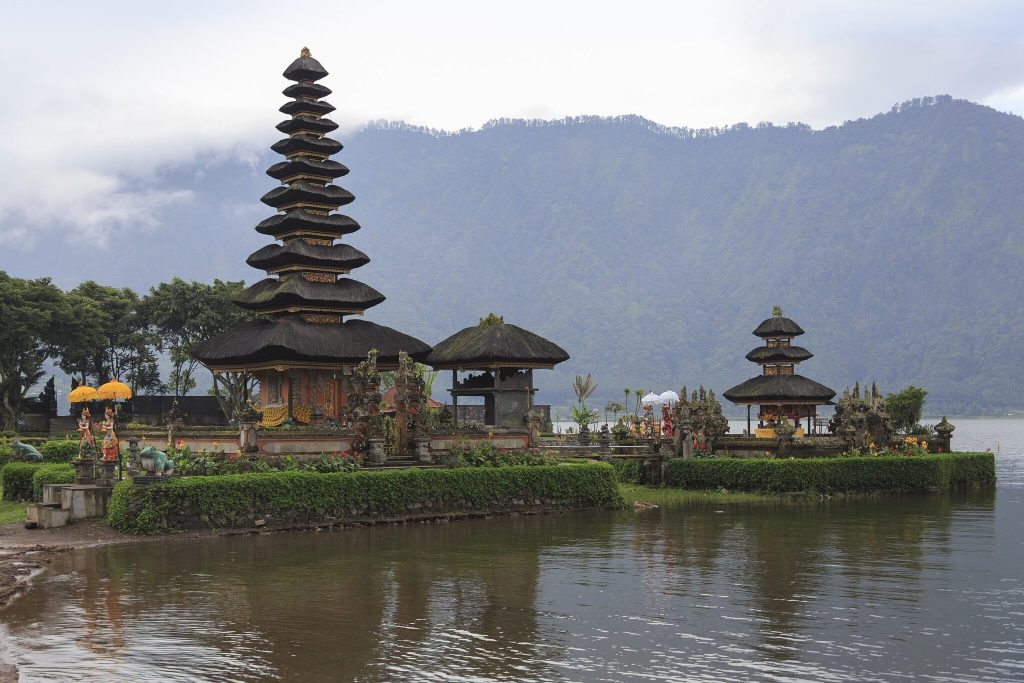
“The beauty of Agama Tirtha is that it is social, cultural and religion together,” Eka says. “Water has energy — powerful energy. It’s purifying, everything in life is about water. Water keeps us alive, grows food so we can eat. Water is holy.”
So when facing growing population pressure in the ninth century, Balinese farmers who needed to expand rice production turned to a water system. They developed irrigated stepped rice terraces to deal with the mountainous terrain and spread this technology across Bali.
The rice terraces, according to Stephen Lansing, were as much a social creation as an agricultural one. Lansing is an ecological anthropologist with the Santa Fe Institute in the U.S., who has researched Balinese social systems for five decades. Farmers organized themselves into local village units, called subak (which eventually became the name for the entire system), to build and support an elaborate irrigation system. They carved tunnels by hand to bring water down from the volcanic lake in the crater of Mount Batur.
To this day, the water continues to pass through an elaborate system of canals, channels, weirs and drainage ditches, irrigating rice terraces on its journey down to the sea.
The rice fields, Lansing says, are “an artificially constructed ecosystem, sustained by continuous human management.” This ecosystem is characterized by nutrient and biochemical cycles, or “pulses,” defined by wet and dry phases. The controlled cycles change soil pH, circulate minerals, stabilize the soil temperature, kill weeds, encourage the growth of nitrogen-fixing algae, and stop nutrient loss into the subsoil, The rich silt flowing down from the volcanic slopes brings necessary minerals, and draft animals contribute manure. Traditionally, farmers rotated their planting between rice, which has a seven-month growing cycle, and other crops. While modern rice farming relies heavily on chemical fertilizers and herbicides, the original system functioned without these synthetic inputs.
Once, says Chakra, the rice fields were “like paradise.” He grew up in them and they taught him about nature and the cycle of life. “I really admire the subak system because I was part of it. When I grew up in this village, there were just rice fields, no roads, no connection to the outside world. Everything was organic, with rich diversity,” he says.
A rice field, full of insects, birds, eels and fish, and its verges, with bushes, trees and food crops, was an open-air supermarket, providing protein, vegetables, fruit, wild greens and rice. Everything, from algae to humans, contributed and took something from the ecosystem.
“I think that’s what heaven is,” Chakra says of this original ecology. “I thought it was the best job in the world to go out in the rice field at night to catch eels, with just an oil lamp, hearing all the sounds of nature, the frogs, and seeing all the fireflies.”
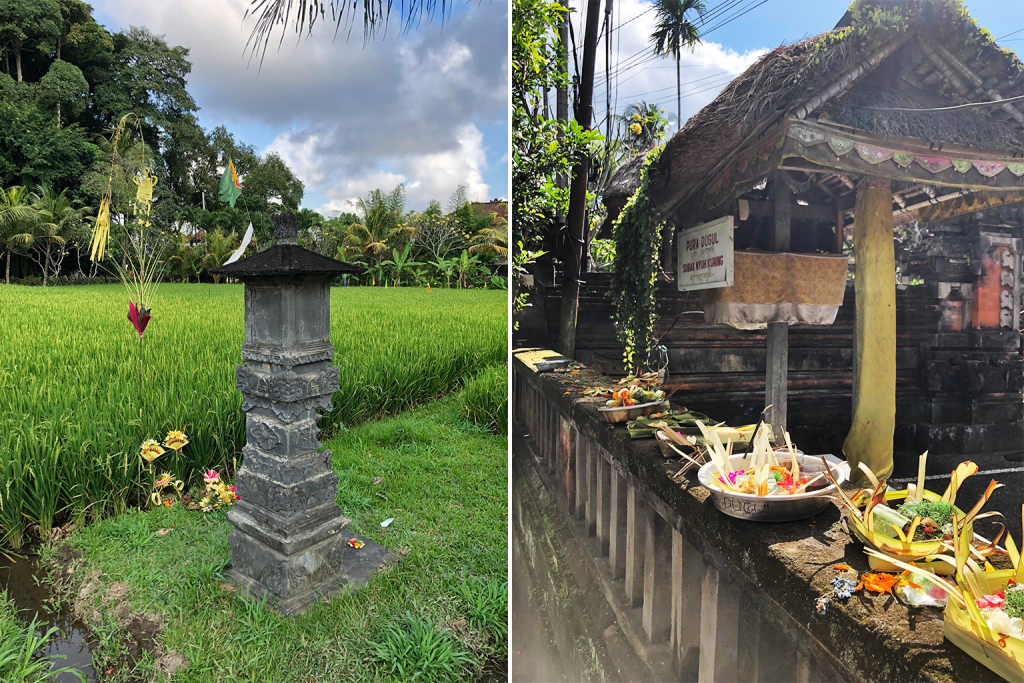
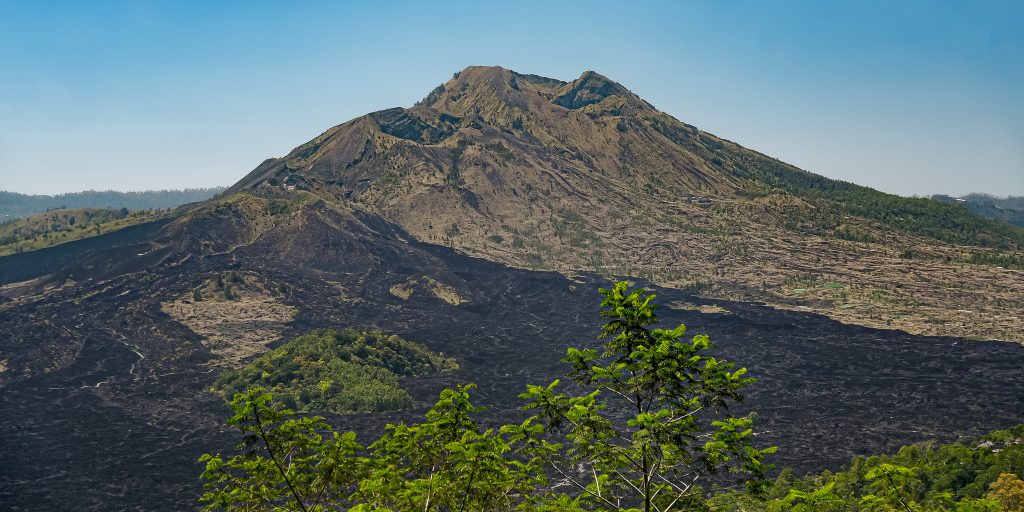
Priests use ritual technology
As subak systems became established across the island of Bali in the 11th century, conflicts over water increased.
To ensure water was shared equitably, the Balinese set up a system of water temples, or pura tirtha, near lakes, rivers and springs. The mother temple sits on Lake Batur, the primary water source, dedicated to the lake’s deity, Dewi Danu. Participating villages must maintain the water temples and subak system and provide offerings for ceremonies. “Agriculture came first, a few thousand years ago,” Chakra says. “Then religion came. [Agriculture] was woven into the religion … so it would not be forgotten, it would be preserved.”
Water temple priests took over managing the subak system using what Lansing calls “ritual technology.” The priests devised calendars to track growing cycles, organize task groups and synchronize rituals and activities with the growing season and the Balinese lunar calendar. They set planting and harvesting dates in consultation with each subak, alternating fields between flooding and fallow cycles to address rice pests and water stress. Water sharing involves a complex schedule of opening and closing dams to distribute water and ensure there’s a balanced patchwork of wet and dry fields so pests can’t spread.
On an island ruled by a caste system, subak is a truly democratic system, according to Lansing. There are about 1,200 subak groups in Bali, each with 40-500 farmers. Each farmer, regardless of their social status, has an equal voice. Anyone trying to pull rank in a group is fined. In extreme cases, where a village or individual routinely violates subak rules, priests can ban them from taking part in religious ceremonies. This has never been done: the threat is enough.
The water temple priests are said to act as intermediaries between the spiritual realm and farming communities. They conduct ceremonies that give thanks and seek guidance and blessings from the gods for a bountiful rice harvest. Water and rice in Bali are associated with the feminine: Dewi Danu, the goddess of the crater lake, whose waters feed the entire subak system, and Dewi Sri, the goddess of rice and fertility. The Balinese say they believe if the goddesses are angered or neglected, water won’t flow, and rice won’t grow.
When Lansing created a computer model of the subak system with ecologist Jim Kremer from the University of Connecticut, he found that water temple management provided the optimal balance between low pest levels and sufficient water.
The efficiency of this “ritual technology” was revealed when it was briefly lost. During the so-called Green Revolution of the 1970s and ’80s, the Indonesian government forced farmers to switch to a new breed of fast-growing, hybridized rice, which needed chemical fertilizers and pesticides. Local authorities took over water management, encouraging farmers to grow as much as they could, ignoring traditional planting and harvesting schedules. Plagues of rice pests, fights between subak groups, and water shortages followed. In 1988, the national government returned control of the subak to the water temples.
However, almost all rice farmers in Bali continue to use agrochemical inputs and the hybridized white rice, according to Chakra.
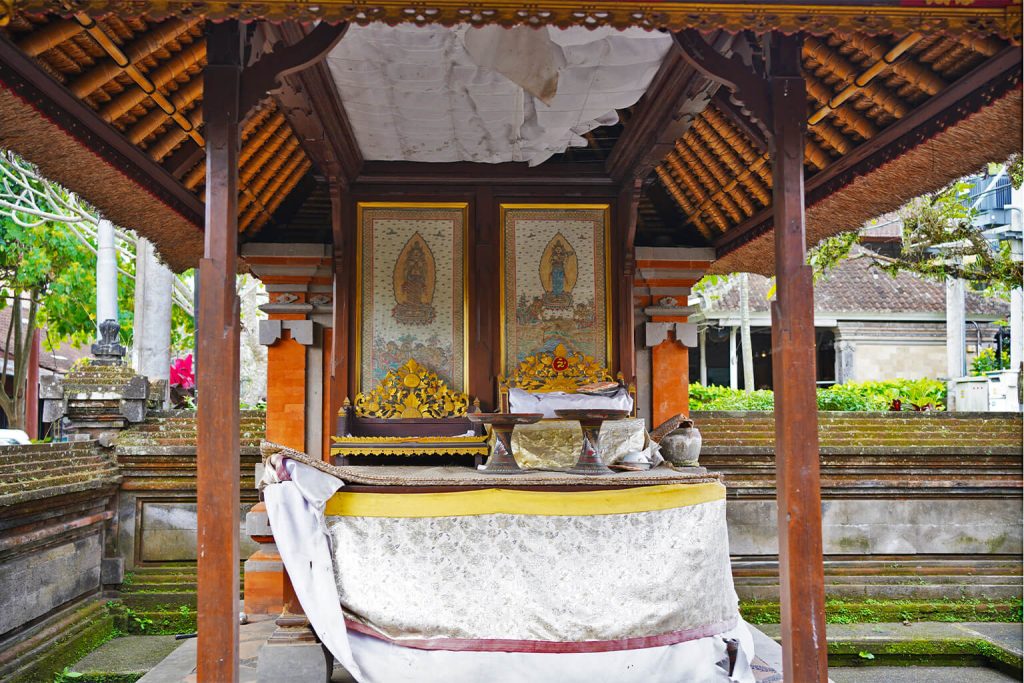
The future of the subak
Chakra grows Taunan Jatiluwih heritage red rice organically on his family’s land and trains other farmers to do the same; organic rice can fetch three times as much as white rice. “Farmers love farming,” he says. “They want to farm. But they need to be paid more.”
Today in Bali, farmers have low social status; the daily rate of a rice farmer who uses agrochemicals is the equivalent of $1.50, according to Chakra, which, over the course of a month, is only about a quarter of the monthly minimum wage in Bali. Young people prefer to work in tourism, so most farmers aren’t being replaced as they age. Chakra says most subak members are older than 50. Farmers must also pay land tax, a system started during Dutch colonial rule. They can often make more money by selling their rice fields.
Today, Chakra’s village is engulfed by Ubud’s sprawl, surrounded by villas and hotels, with few rice fields left. He says he plans to move north, away from tourist areas, where subak systems are largely still intact.
Eka’s family fields in the neighboring village of Nyuh Kuning can no longer grow anything; the nearby hotels, built on former rice fields, have blocked the ancient water channels to their land. Now, she says, her family has no choice but to rent out the land to foreigners to build a house. “We will get the land back in 15 years [when the rent contract ends],” Eka says. “But we can never use that land for food again.”
She says she worries that the next generation of Balinese is becoming disconnected from nature, and that subak rites may become empty words for them. But Lansing disagrees, saying the priests and water temples are still as influential as ever in Balinese society.
“Before, the sawah [rice field] was a good way to teach kids about the ecosystem, about birds, water, nature and Tri Hita Karana,” Eka says. Now, in school, her young son learns only that subak is an ancient irrigation system. Eka takes him to a neighboring village with an intact system to show how it works. “I try to explain to him that subak is really something special, but it will be changed if you do not keep it,” she says.
Currently, Bali loses about 1,000 hectares (2,500 acres) of agricultural land per year to development, mostly for tourism. Tourism also uses 65% of Bali’s water, competing with farmers as climate change dries up Bali’s rivers and streams. UNESCO World Heritage status protects 19,500 hectares (48,200 acres) of the subak system but this is only part of a total 154,000 hectares (380,500 acres) under rice cultivation in Bali. The watershed forests on Batur are recognized as being part of subak by being a source of mineral-rich water, according to Lansing.
Lansing and I Wayan Alit Artha Wiguna, head of agricultural extension training in Bali for the Indonesia Ministry of Agriculture, are testing a methane emissions reduction project using low-water, low-fertilizer farming in the subak of Bena village. Globally, 11% of methane emissions come from flooded rice fields. The trials show 85% emissions reduction and 20% higher rice yields in the Bena subak, The farmers say they’re happy with the increased yields and lower input costs, which increases their profits. Nearby farmers say they’re interested. Lansing and Alit want to incorporate carbon credits into the scheme to increase farmer incomes. If they can convince all 80 Bena farmers to use the new method, the unity of the ancient system may persuade all subak in Bali to change, they say.
Banner image: Farmers on rice terraces in Bali. Image by Philipp Al via Flickr (CC BY 2.0).
https://news.mongabay.com/2024/08/in-bali-water-temple-priests-guide-a-sustainable-rice-production-system/Published Date: August 27, 2024




